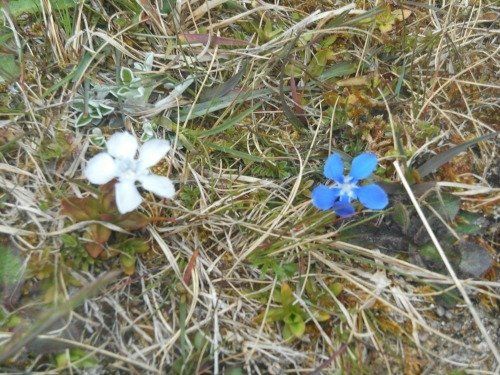The Burren

The Burren 2016 is finally blooming after an uncommonly cold
spring. The region is considered to be of true international importance for its
Arctic, Alpine and Mediterranean flower admixture. The mystique lies in the
melange.
I have picked out an example of a plant from all three regions and profiled
them briefly as below. The three species are blooming at the time of writing.
I also strongly recommend a pocket book which is indispensable when botanising
in the region.
Bain súp as! Enjoy!

SPRING GENTIAN/GENTIANA VERNA/CEADARLACH BEALTAINE
A small member of the gentian family with the stem measuring
only a few centimetres. The name derives from King Genthios of Illyria
who was credited with discovering the herbal properties of the plant. The king
reigned a couple of centuries before Christ and Illyria was a kingdom in today’s
western Balkans.
The gentian is an astonishing metallic-blue colour. It is the symbol of the Burren region and flowers from April to early June. The flower is Alpine and is quite rare in the north of Europe. Teesdale is the only region in Great Britain where it grows. I ireland, the Gentian can only be found in a few scattered limestone localities in the west.
Spring Gentian is associated with mountainous limestone
regions of central Europe and parts of Asia.
In the Burren, it is one of the montane plants which also grows at sea level. Moreover,
it co-mingles in the region with orchids from the Mediterranean basin. This
cold/warm climate plant melange makes the Burren a significant botanical
region at a world level.

IRISH ORCHID/NEOTINEA
MACULATA/MAGAIRLIN GLAS
Orchids are one of the largest wild plant communities. More than 25 thousand species have been identified. The grand total of 56 species can be found in
Ireland and Great Britain. The small Burren region (200 square miles) is home
to an impressive 24 of the British and Irish species.
Most of the Burren orchids flower in May and June. The Early
Purple Orchid/Orchis Mascula and the Irish Orchid are the first to bloom. The
Irish orchid is also known as the Dense-Flowered Orchid. It is a small orchid
with densely-packed and cream-coloured flowers.
The plant has an astonishing geographical distribution. In
the north of Europe, it only grows in a few limestone localities in the west of
Ireland. The orchid otherwise grows further south in the world in regions such
as the Mediterranean and North Africa.
Its range also extends east as far as the Ukraine.
Irish Orchid is known as a Lusitanian flower – part of a tiny group of Mediterranean plants native to Ireland but absent from Great Britain. Lusitania is the Latin name of a former Iberian Roman colony which corresponds to most of modern day Portugal and part of Spain.
The Burren is the only region in the world where the Irish Orchid and Spring Gentian grow together!
The Irish name of the plant is Magairlín Glas, the Green Orchid.
MOUNTAIN AVENS/DRYAS OCTOPETALA/LEAITHIN
Mountain Avens is a member of the rose family. It is an Arctic plant which occurs in montane regions in the northern hemisphere. It is called Dryas Octopetala in Latin. The octopetala part of the name is explained by the fact that most specimens have 8 petals. As the leaves are oak-like, dryas also features in name. There is a poached egg look about the flower. It is the national emblem of Iceland.
The rootstock is quite woody and some define the plant as a shrub. The Burren uplands were treeless in the 19th century due to immense pressure on the land by a large and desperate population. In fact the pressure was so great that the rootstock of the Avens was being harvested for fuel for the fire. It must have been very labour-intensive and desperate work……. all also in the context of a potato famine (1845-49) which ravaged the region.
Mountain Avens, just like Spring Gentian, grows enigmatically at sea level in the Burren.

THE BOOK
Don’t go without the book! The Wild Plants of the Burren and the Aran Islands
by the botanist
Charles Nelson. The excellent field guide was first published by The Collins Press in 1999.
The third edition issued this year and it features 139 of the region’s wild
plants with colour photographs and text. It is an invaluable
resource in the great Burren outdoors in the blooming season.
Nelson was born in Belfast in 1951. He was taxonomist (scientist in the classification of plants) in the National Botanic Gardens in Dublin for 19 years. He has had written more than 20 books including the magisterial The Burren a companion to the wildflowers of an Irish limestone wilderness with illustrations by Wendy Walsh. The book is published by The Conservancy of the Burren Ltd. Nelson is now a freelance botanist, writer and leader of botanical tours. He has been living in the Norfolk fens in the east of England since the mid-1990s.



